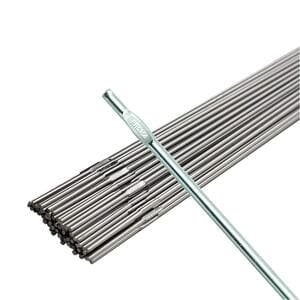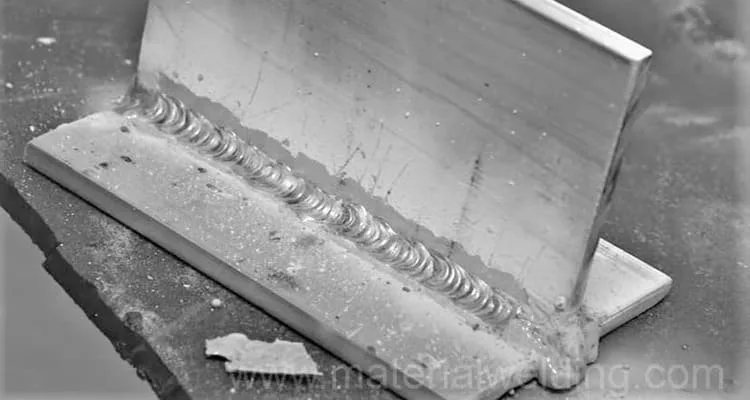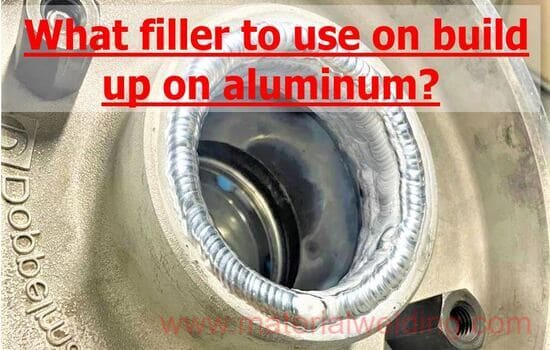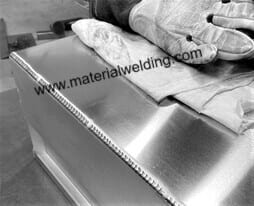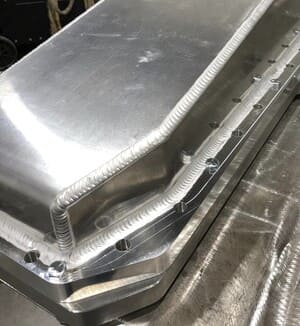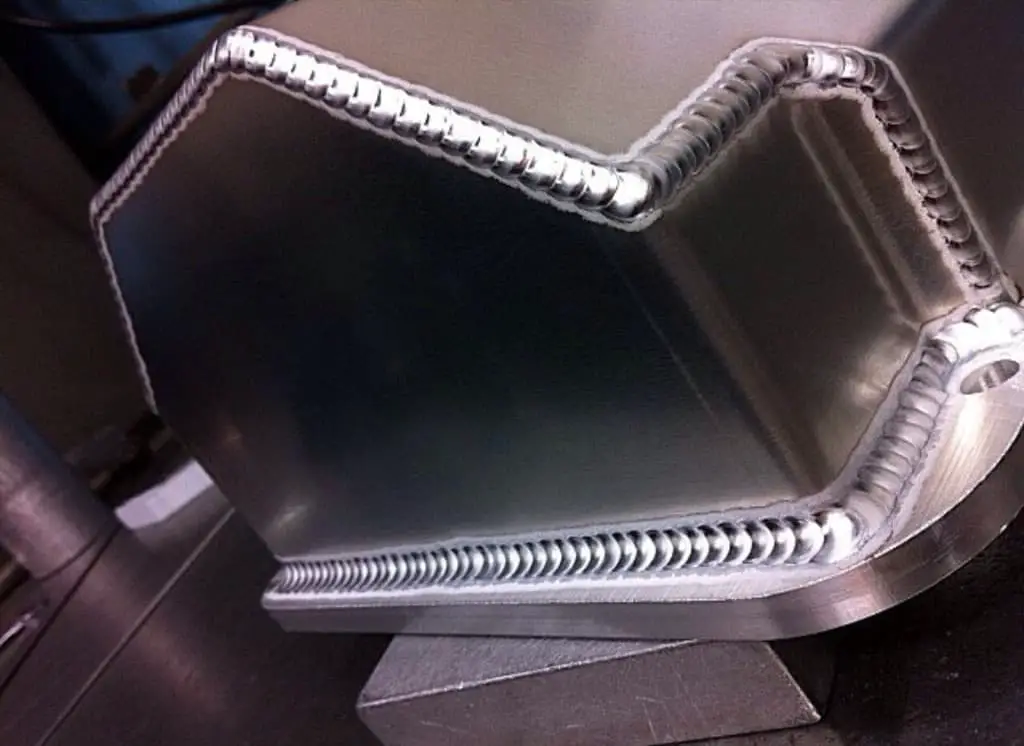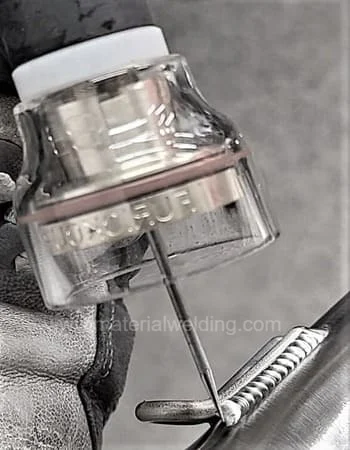E4043 Aluminum Welding Rod
E4043 is a type of aluminum welding electrode used for stick welding (SMAW) applications. It is typically used to weld aluminum alloys such as 6XXX, 5XXX, 4XXX, 3XXX and 1XXX series.
E4043 rod is used to weld aluminum grades 6061, 5052, 4043, etc. The electrode is made of aluminum alloy that has been alloyed with silicon and other elements to enhance its welding properties.
Extra silicon provides good molten pool fluidity which otherwise can be very sluggish.
Read more: How to stick weld Aluminum?
E4043 Aluminum Welding Electrode Specification
E4043 aluminum welding electrode specification is AWS A5.3. AWS A5.3 specified the chemical and mechanical properties of this rod.
DIN 1732 equivalent aluminum rod specification is EL-AlSi 5.
F Number of E4043 welding rod is “23“. You can use successfully following stick welding electrodes for welding aluminum easily:
Below are the chemical and mechanical properties of E4043 welding rod as required by AWS A5.3 Specification.
E4043 Aluminum Welding Chemical Compositions
the chemical compositions for E4043 aluminum welding electrode as per AWS A5.10 specification:
| Chemical Element | Composition (%) |
| Aluminum (Al) | 93.0 – 96.5 |
| Silicon (Si) | 4.5 – 6.0 |
| Iron (Fe) | 0.80 max |
| Copper (Cu) | 0.30 max |
| Manganese (Mn) | 0.05 max |
| Zinc (Zn) | 0.10 max |
| Titanium (Ti) | 0.20 max |
| Beryllium (Be) | 0.0008 max |
| Others | 0.05 max each, max total 0.15 |
E4043 Aluminum Welding Electrode Mechanical Properties
The mechanical properties for E4043 aluminum welding electrode are as follows:
- Tensile strength: 14,000 psi (95 MPa)
- Yield strength: Not specified (Typical values 90,000 psi (60 MPa)
- Elongation: Not specified (typically >12%)
Tensile strength is the maximum stress a material can withstand while being stretched or pulled before breaking.
Yield strength is the amount of stress a material can endure before it starts to permanently deform.
Elongation is a measure of a material’s ability to stretch without breaking.
E4043 welding Rod Baking & conditioning
Moisture in the covering of the E4043 aluminum electrode is a significant cause of porosity in welding, and contamination such as dirt or grease can also contributing factor for welding porosity.
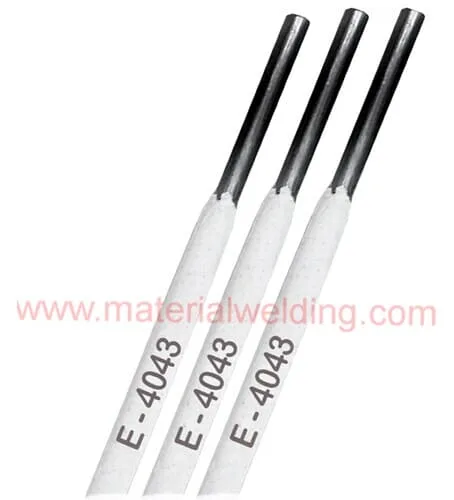
The covering of E4043 rod can quickly absorb moisture and degrade, so 4043 electrodes should be stored in a dry and clean place.
If E4043 welding electrodes have been previously opened or exposed to moisture, they should be heated to 350-400 degrees Fahrenheit (175° to 200°C) for an hour before welding and kept in a heated cabinet at 150-200 degrees Fahrenheit ( 65° to 95°C) until they are used.
Read more: Low hydrogen Electrode Baking Procedure.
E4043 welding Rod Preheating temperature
Due to aluminum’s high thermal conductivity, preheating to 250-400 degrees Fahrenheit (120° to 200°C) is typically required for welding thick materials to maintain the adequate weld pool and achieve good welding fusion.
Preheating also helps prevent porosity caused by the rapid cooling that occurs in the welding zone at initial weld start. This is also to prevent distortion in complex welding assemblies & structures.
Preheating can be done using a torch with oxygen and acetylene or other fuel gas, or through electrical resistance heating.
However, it’s important to note that the mechanical properties of 6XXX series aluminum-alloy (E.g., 6061 grade) welds may be significantly reduced if higher preheating temperatures of 350 degrees Fahrenheit (175°C) or higher are used.
This is because of elimination of their tempering effect at this temperature.
E4043 welding Rod Polarity
E4043 aluminum welding electrode is typically used with DC (direct current) power sources and is operated with reverse polarity, also known as electrode positive (EP).
This means that the electrode, or the filler metal, is connected to the positive terminal of the welding power source, and the workpiece, or the base metal, is connected to the negative terminal.
DCEP welding polarity provides a smooth welding arc with good weld pool cleaning.
E4043 Welding Rod settings
welding electrode is determined by the electrode diameter and the thickness of the base metal.
The thicker the base metal, the higher the amperage required to produce a strong and consistent weld.
Here are some general amperage recommendations for E4043 welding electrode for different electrode diameters and base metal thicknesses:
- 1/8 inch diameter electrode:
- Sheet metal: 70 – 90 Amps
- Base metal up to 1/4 inch thick: 90 – 110 Amps
- Base metal over 1/4 inch thick: 110 – 130 Amps
- 5/32 inch diameter electrode:
- Sheet metal: 90 – 110 Amps
- Base metal up to 1/4 inch thick: 110 – 130 Amps
- Base metal over 1/4 inch thick: 130 – 150 Amps
- 3/16 inch diameter electrode:
- Sheet metal: 80 – 100 Amps
- Base metal up to 1/4 inch thick: 100 – 120 Amps
- Base metal over 1/4 inch thick: 120 – 140 Amps
What is E4043 aluminum welding?
What are the properties of E4043 filler metal?
It has good fluidity and is easy to use, it also has low melting point, good corrosion resistance and high strength.
What are the advantages of using E4043 filler metal for aluminum welding?
– Good fluidity and ease of use.
– Low melting point, which helps to reduce the risk of cracking and distortion.
– Good corrosion resistance and high strength.
How do I prepare the aluminum surface before welding with E4043 rod?
This can be done using a degreaser or a wire brush. The surface should also be dry and free of moisture.

